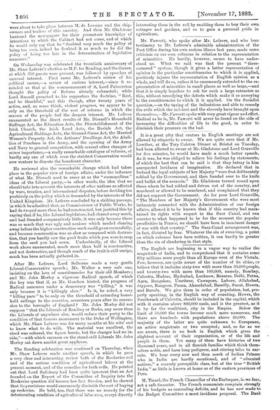The English are beginning in a vague way to realise
the magnitude of India, and to comprehend that it contains some fifty millions more people than all Europe west of the Vistula. Few, however, are quite aware of the number of its cities, or believe that it includes sixty-two with more than 50,000 people, and twenty-two with more than 100,000, namely, Bombay, Calcutta, Madras, Hydrabad, Lucknow, Benares, Delhi, Patna, Agra, Bangalore, Umritsur, Cawnpore, Lahore, Allahabad, Jeypore, Rangoon, Poona, Ahmedabad, Bareilly, Surat, Howra, and Baroda. We give them in order of population, but, pro- perly speaking, in the English way of counting, Howra, the Southwark of Calcutta, should be included in the capital, which with it contains above 866,000 souls, and is the greatest, as it is by far the wealthiest, city in the Empire. Below the limit of 50,000 the towns become much more numerous, and there are hundreds with populations above 20,000. The majority of the latter are quite unknown to Europeans, an active magistrate or two excepted; and, so far as we- are aware, there is no book in English which gives the slightest account of their organisation, or of the life and people in them. Yet many of them have histories of two thousand years, and in all flourish families which think them- selves noble, and have long pedigrees, and stirring tales to nar- rate. We hear every now and then much of Indian Princes who in India are hardly mentioned, and of " educated natives," a scarcely perceptible class, but of the true "British India" as little is known at home as of the eastern provinces of Peru.


































 Previous page
Previous page